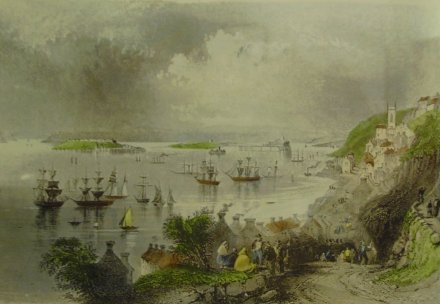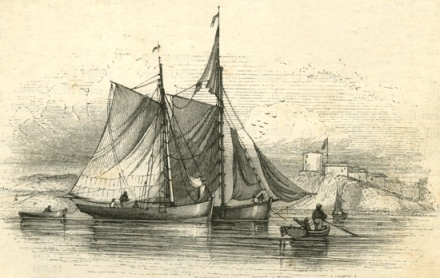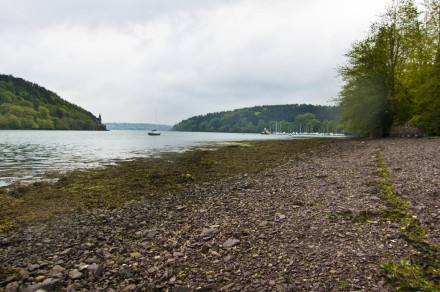
The Cove of Cork from Summerhill about 1830, when the battle of the Ballybricken oysters took place. The great expanse of Cork hHrbour is in the centre of the picture. The various vessels are situated in the road, or anchorage beside the deep water passage to Cork. Spike Island with its fort is on the left and the headland of Ringaskiddy is in the centre. Haulbowline Island, only then about to be developed as a Royal Navy dock, is just to the right. Just behind Haulbowline is Ballybricken and its oyster beds. The town of Cove became Queenstown in 1849 as a result of Queen Victoria’s visit. It was renamed Cobh in the 1920s, after the creation of the Irish Free State.
On 21 January 1830, the Mary, a hooker (fishing boat), slipped away from Rathcoursey a few miles south of Midleton and Ballinacurra. The vessel sailed south down the Ballinacurra River – the channel that separates Great Island from East Ferry in the north-eastern corner of Cork Harbour. Once she exited the channel into the main body of the lower harbour, the Mary turned west and headed across the waterfront between Cove (as it was then called) and the island of Haulbowline to reach the rich oyster beds of Ballybricken, just west of Ringaskiddy, on the western shore of the harbour.

Single-masted hookers were typical of the better fishing boats used in Cork Harbour from the late 18th century. This was the type of vessel that the Mary of Rathcoursey resembled in 1830. The hookers in this image are shown moored off Haulbowline Island.
There the crew of the hooker began to trawl for oysters. Unfortunately they were spotted by five fishermen from nearby Monkstown. These men had license from Mr John Smith-Barry of Fota to harvest the oysters at Ballybricken. This newly arrived vessel was very clearly a stranger, and had absolutely no right to take oysters from Ballybricken. Immediately the Monkstown men raised the alarm and set off on a whaleboat to intercept the invaders. Both crews immediately set to and began to assault one another. Weapons were used – clubs, staves, knives, axes, even the odd blunderbuss and ballast stones! With the arrival of more men from Monkstown and Passage, the crew of the Mary realised they were fighting a losing battle and appealed for assistance to the master of a schooner, the Navarino, which was anchored nearby. Astonishingly the captain of the Navarino invited the hooker’s crew to come aboard his vessel. He really should have known better!

The Ballinacurra River is not actually a river but a passage between East Ferry (on the left) and Great Island on the right linking the shallow waters of the inner reaches of Cork Harbour and Ballinacorra port with the lower harbour and the open sea. It was through this passage that the hooker Mary sailed from Rathcoursey in January 1830. The church on the left of the picture, standing tight beside the water, (spire just visible) is East Ferry church or Holy Trinity Church, Garranekennefeake, built by the William Atkins for the Church of Ireland in 1867 to replace a long vanished medieval church. Despite the presence of a large power station at Aghada (actually in sight of the church!), Holy Trinity was never connected to the electrical grid and even today it still does not have any electricity supply!
As the crewmen from Rathcoursey boarded the Navarino, they were quickly followed by the Monkstown and Passage fishermen. The result was a complete brawl involving the crewmen of the Navarino, the Rathcoursey fishermen and the fishermen from Monkstown. The master of the Navarino realised he had to quell this full-scale riot on his deck and he appealed to a Royal Navy vessel that was anchored nearby. This vessel was the HMS Pearl – she bore the same name as the ship that finally finished the career and life of the pirate Edward Teach, Blackbeard, in 1718. The Pearl sent over her complement Royal Marines, who promptly knocked heads together and quelled the riot.
HMS Pearl then towed the Navarino, the hooker and the Monkstown whaleboats to Cove where the rioting men were given medical attention was provided for the injured (one man lost an eye, several had lacerated limbs). More importantly the men were all surrendered to the local magistrates who would conduct inquiries and press charges for breach of the peace. So ended HMS Pearl‘s intervention in the battle of the Ballybricken oysters.

View of Haulbowline Island in the middle of the 19th century as the Royal Navy stores were built. The land behind it includes the townlands of Ballybricken and Ringaskiddy.
Many people today do not realise that Cork Harbour once contained several oyster beds which by the early 1800s were proving to be quite lucrative for the local fishermen. Often these fishermen from different communities would might actually fight one another over access to productive oysterbeds in the harbour. A classic example of this was the battle of the Ballybricken oysterbeds in 1830. To understand the importance of this it should be noted that after the end of the Napoleonic Wars in 1815, the Royal Navy reduced its complement in Cork Harbour.
This happened because the French were no longer a threat to either Ireland or to the ships sailing from Britain to her colonies in the West and East Indies, and Australia. At times during the previous twenty five years of war it was said that up to three hundred ships could be seen in the outer harbour awaiting escorts for their convoys. Sometimes these vessels were obliged to wait several weeks for a convoy to assemble, especially if the winds were wrong. During that period the ships anchored in the harbour had to be supplied with victuals and other goods, so that they did not consume the supplies laid on for the voyage. This generated a lot of lucrative business for Cork and the towns and villages around the harbour. One of the biggest beneficiaries was the brewing firm of Beamish and Crawford in Cork. Until the 1830s theis was the biggest brewer in Ireland. It was then overtaken by a pushy brewer from Dublin called Arthur Guinness and Sons.

View of Haulbowline from Great Island as it was developed by the early 20th century. Haulbowline was extended in the later 19th century by building a Royal Navy dockyard which incorporated a potentially hazardous reef. The Royal Navy held Haulbowline and the harbour until 1938.
The collapse of the wartime economy hit the region very hard. Men were no longer required for the Royal Navy and were laid off. The captive convoy market simply disappeared. Local firms let employees go. This meant that the local people had to rely on their small market gardens and on fishing for survival. During the 1820s a severe depression afflicted the local economy. This increased the tensions between local communities over access to lucrative fishing and oyster grounds. Hence the brutality the battle of the Ballybricken oyster beds in 1830.